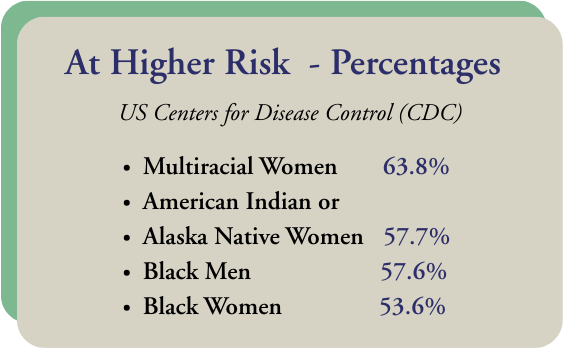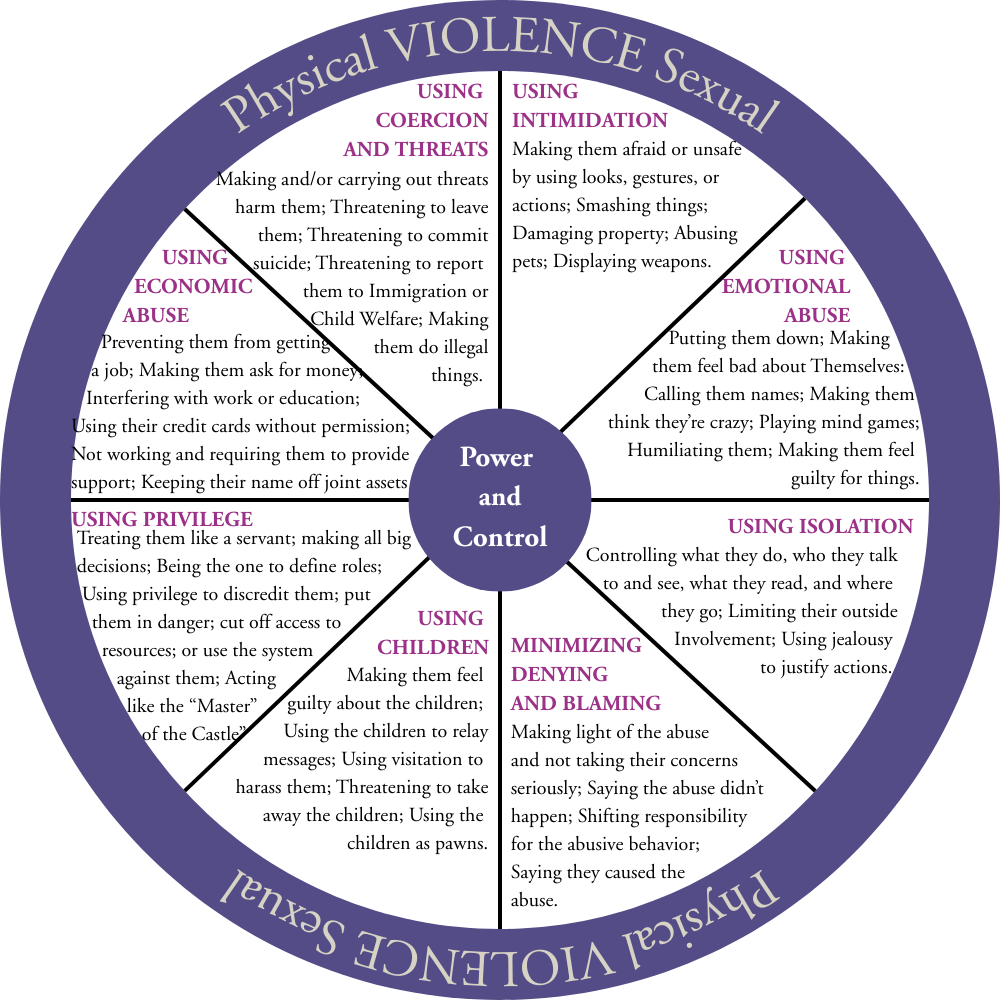Domestic violence describes actions and patterns of injury and mistreatment by someone in an interpersonal relationship intended to exert or maintain power over an intimate partner by current or former partners. The alternate term “intimate partner” violence expands the definition to include relationships between couples who are not living together. “Family violence” further extends to cases in which other immediate family members are victimized by violent or abusive behavior.
Types of Abuse

Physical |
|
Sexual |
|
Emotional or Psychological |
|
Financial |
|
Higher Risk Demographic Groups

While people of all races, socioeconomic and ethnic backgrounds, gender identities, and sexual orientations are victimized by intimate partner violence, certain demographic groups face an increased statistical risk.

Additionally individuals who self-identify as lesbian, gay, or bisexual also face increased statistical likelihood of rape, stalking, and physical violence at the hands of an intimate partner. For more information visit: Recognizing Domestic Violence in LGBTQ+ Relationships
Power and Control

The Power & Control Diagram is a particularly helpful tool in understanding the overall pattern of abusive and violent behaviors, which are used by an abuser to establish and maintain control over his or her partner.

5 Myths about Domestic Violence

Myth 1. It couldn’t happen to me.
Intimate partner violence occurs in all parts of society. No one chooses to date an abuser. Abusers hide their true colors until AFTER it becomes difficult to leave the relationship.
Myth 2. Victims are partly to blame.
A partner has no control over the actions of the abuser and it is NEVER their fault. Abusers often make unrealistic demands and expect the impossible. Victims become exhausted trying to please them to keep the peace. Abusers use violence, emotional and verbal abuse, threats, children, finances and other tactics to maintain power and control in the relationship. They blame the victim to justify and continue their own abusive behavior.
Myth 3. It’s easy to leave.
Many DO leave, but it is NOT easy. Abuse often starts after the relationship is hard to leave, and abusers use manipulative tactics like apologizing, promising to change, or blaming the victim to keep them around. Most victims are afraid to leave and many don’t have the financial resources to leave or a place to go. The victim also knows that the level of danger increases when they are about to leave. They may also feel they have limited options if they are isolated from family and friends or if they do not control the finances.
It’s never easy for a victim of domestic violence to leave. Unlike a healthy relationship where a break up is still often difficult, in a dangerous relationship people don’t break up. They escape.
For a riveting first-hand account, see this TedTalk by Leslie Morgan Steiner.
Myth 4. People just lose control sometimes.
People don’t abuse because they are out of control. Domestic violence is a choice and abusers are rarely violent outside of the relationship. They are very careful about where and when they choose to abuse in order to hide their actions. If the police are called, it is often the victim who is hysterical while the abuser is calm. Violence is a calculated tactic that abusers use to maintain power and control. And while drugs and alcohol may cause abusers to be more violent, these substances do not cause abusive behavior.
Myth 5. There is nothing I can do.
There are three things anyone can do to help survivors of domestic violence.
- First, you can believe the survivor’s experience and honor them. When people dismiss or blame them, survivors are re-victimized.
- Second, we must hold abusers accountable. We must not make excuses for unacceptable behavior or be afraid to get involved in “private matters.”
- Third, we can donate or volunteer with an organization like Willow Center to help eradicate domestic violence.
Is this Abuse?

If you’re beginning to feel as if your partner or a loved one’s partner is becoming abusive, there are a few behaviors that you can look out for. Watch out for these red flags and if you’re experiencing one or more of them in your relationship, call the Willow Hotline to talk about what’s going on.
- Embarrass you with bad names and put downs?
- Look at you or act in ways that scare you?
- Control what you do, who you see or talk to, or where you go?
- Stop you from seeing or talking to friends or family?
- Take your money or Social Security, make you ask for money, or refuse to give you money?
- Make all the decisions?
- Tell you you’re a bad parent, or threaten to take away or hurt your children?
- Act like the abuse is no big deal, it’s your fault, or even deny doing it?
- Destroy your property or threaten to kill your pets?
- Intimidate you with guns, knives or other weapons?
- Shove you, slap you or hit you?
- Force you to drop charges?
- Threaten to commit suicide?
- Threaten to kill you?
Does your partner:
If you answered “yes” to any of the above questions, you may be in an abusive relationship.

